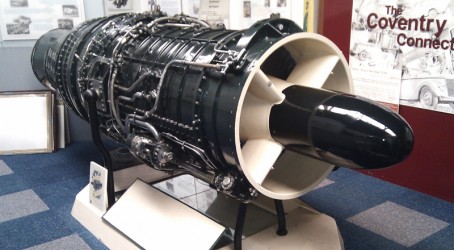At first glance the Midland Air Museum appears to be in a time-warp – hangars, sheds and retired aircraft lie clustered together on a plot of land just north of Coventry airport. But appearances can often be deceiving and such is the case with this intriguing place.
It’s worth taking the time to uncover its collections of engines, large-scale models and fascinating artefacts which narrate the story of jet engines and jet-powered aircraft.
The museum was started in 1967 by local enthusiasts who collected books, photographs and aircraft parts. With just five aircraft on display, the museum opened its doors in 1978. Over the next 10 years the collection expanded with the arrival of a Vulcan bomber and an Argosy freighter, as well as the opening of the Sir Frank Whittle Jet Heritage Centre. The Whittle Gallery, dedicated to the father of the jet age, is tucked away inside the main hangar. It chronicles his early life and his work as an engineer and inventor. Once you get past the cluttered look and feel of the display, it is insightful and packed full of fascinating facts.
The main hangar holds four planes that used power units directly descended from Whittle’s engines. Meteor F.4, the oldest jet-powered aircraft at the museum and Britain’s first jet fighter, can be seen here, along with the Saab J29 Tunnan, Lockheed T-33 Shooting Star and the de Havilland Vampire.
Another exhibition showcases the aviation industry in Coventry after World War Two, when it was at the forefront of technology and innovation. Tribute is paid to companies such as Armstrong Siddeley, Alvis and BTH, which produced components including jet engines, wheels, tyres, undercarriages, engine starters and a host of other high-tech items.
The museum’s impressive engine collection spans more than a century of development. There are piston aeroengines from the early 1900s, such as the Alvaston and the Humber; turbojets such as the Olympus, which powered the Vulcan; and the reheated Rolls-Royce Spey turbofan, the largest engine in the collection.
Many of the jet engines are still mounted within their airframes, so it’s not always easy to get a close look. Fortunately, some engines have been partially sectioned to reveal the inner workings, while others have been entirely removed and are on display individually.
The story of the jet is continued in the external display area, where a variety of designs produced by the British aircraft industry is represented. Carrier-borne types such as the Hawker Sea Hawk, de Havilland Sea Vixen and Fairey Gannet are on display, as are RAF fighters such as the Vampire, Hunter, Javelin and Lightning.
Jet bombers are represented too, most notably by the English Electric Canberra and the huge Avro Vulcan nuclear bomber.
The collection also includes airliners, such as the Vickers Viscount, and helicopters.
There are very few places where visitors can get hands-on and sit inside plane cockpits, but the Midland Air Museum is one of them. Visitors are invited to climb inside the Meteor, Canberra, Sea Vixen and the Harrier training cockpit.
A particular favourite with visitors is the Vulcan, which is open on most days.

Five things to see
Power Jets W2-700 turbojet engine: Designed by Frank Whittle, it powered the Gloster E28/39, Britain’s first jet aircraft.
Armstrong Siddeley Sapphire: The Hawker Hunter and the Gloster Javelin were powered by this engine.
Avro Vulcan B.2: Visitors can jump into the pilot’s seat of this famous nuclear bomber.
Gloster Meteor F.4: Britain’s first operational jet fighter entered service in 1944.
McDonnell F-101F Voodoo: US air force’s powerful fighter could destroy a formation of bombers in a single shot.